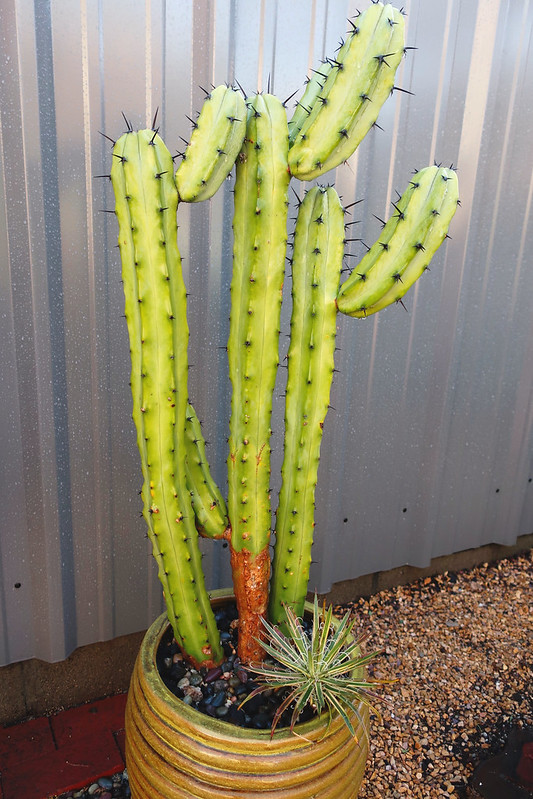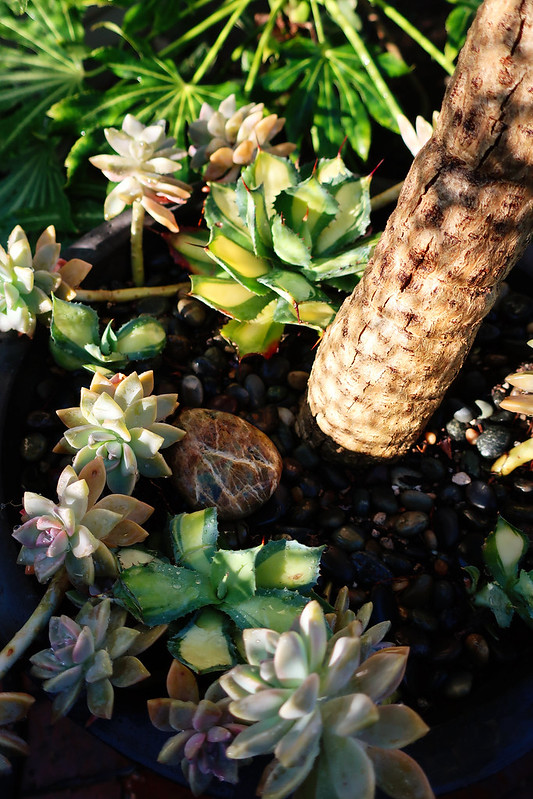Does the world distract me from my garden or the garden distract me from the world? The balance has been different at various times in my life, so I like that the relationship is flexible. Spending most of my days in the garden now, I’ve recently had a minor epiphany concerning potted plants. This is probably not news to lots of you, but I can be slow at times to break old habits.
With rare exceptions, I’ve always grown potted plants as single specimens, usually mulched with gravel. Last year, without much of a plan, I began filling in the larger containers with excess echeverias from the garden. They multiplied fast and grew pristine and unblemished, and when I was planting up the new gravel garden area, I had a ready supply at hand.
That was all the encouragement I needed. I’ve now become an enthusiastic convert to the idea of filling the base of slow-growing potted plants with small succulents (duh!) — so I’ll have a luxurious amount to spread around the garden in large drifts, an effect I love in mature gardens.
And it’s funny, once an old bias dissolves, all kinds of possibilities open up. Like combining small, slow-growing agaves with cactus, which I did recently when repotting a large myrtillocactus.
My little potted agave treasures? They’re getting the same treatment, like this ‘Rum Runner’ planted at the base of Cussonia spicata. Small, profusely pupping — why not treat them like echeverias when they behave like echeverias?
Those terrestrial bromeliads like dyckias and hechtias I’ve banished from the garden because of their blood-drawing, expansive colony-forming ways? I’ve kept a few individually potted, and they struggle from the neglect that comes when I’m conflicted about a plant. With the new approach, I can appreciate how well this dyckia works with Pilocereus azureus (also neglected) — a juxtaposition I’d include in the garden if I planted such spiny things in the ground, which I generally do not in this very small garden. Who knows, one day there may be puppies roaming the garden again…
With my ‘Gold Star’ beaucarnia needing repotting to a larger size, and having shed the prejudice about keeping the base of the plant covered in only gravel, I indulged in some purposeful plant shopping.
Echeverias ‘Blue Prince’ and ‘New Black’ spoke to me out of dozens of succulents I considered. I want lots more of these propagating in this little nursery at the base of the beaucarnia, away from foot traffic, slugs etc.
So that counts for excitement around here. Of course I’ve been prowling the local nurseries in general, hoping to find the ones that carry stock from Annie’s Annuals flush with new arrivals. Nope — in fact, as far as I can tell, Annie’s Annuals doesn’t appear to be available anywhere locally this year.
I did find one of her plants at International Nursery, this Dombeya burgessiae, because International has the habit of potting up unsold plants and offering them again in bigger sizes the next season. This dombeya has fremontodendron-like leaves, with flowers and bracts that present some interesting brownish-pink tones. It’s a small South African tree that reputedly is fine indefinitely in a container. Maybe I’ll slip in some succulents at its base once I get to know the dombeya a little better.
More scenes from the garden this March:
I’ve been astonished to discover what a good strong vertical presence the giant purple crinum has turned into, like having a year-round, gigantic Eucomis ‘Sparkling Burgundy.’ I guess I assumed it would splay out and lounge and misbehave, but this flea market purchase has turned into gold. I almost prefer it to a dark phormium. Unfortunately, it’s rarely offered at local nurseries and always on the expensive side when it is.
The leaning trunk of the giant dandelion, Sonchus palmensis, is unseen in this photo, but it’s getting near parallel to the ground. With all the wind we’ve been having this March, every morning I expect to wake up to it toppled over — incredibly, it remains upright. It can grow on cliffs and among rocks, so the taproot must be able to handle strong winds. I’ve placed some rocks at its base as insurance, but I’m wondering if I shouldn’t stake it as well.
Leucospermum ‘Tango’ is one of those slow flowers that takes its time to unfold into bloom, a mesmerizing performance. And the flowers last and last in the cool winter temperatures. Quite the contrast to growing flowers in summer, like my cosmos experiment last summer that I doubt I’ll be repeating.
The albucas continue to delight in small containers — they’d get lost in the garden.
And that’s pretty much what I’ve been up to — getting lost in the garden!


























I’m pretty sure your Echeveria imbricata or what up near the top is E. puldonis–the yellow flowers are the giveaway. Coincidentally I’ve also been thinking about bare soil at the base of large plants in pots. I think you’ve nudged me to give it a try. How many hours of sun does your Sonchus get ? I’ve wanted on for years but I think I have too much shade in the only open spot.
Kathy, yes, pulidonis! Thanks. I broke down and staked the sonchus this morning after strong rain and wind all night — yes, rain in LA! The sonchus is in a winter shade band for two months until February, except for the very top of its 5-foot length, which might account for its leaning. If I remember correctly, the sonchus at SF Bot seemed to be growing in dappled shade, a whole hillside of them!
I agree it does take a bit of effort to shake off old habits. I have started poking cuttings and stray bits into larger containers and am surprised how easily everything is rooting and growin together. Your Beaucarnea is impressive and gorgeous.
Another layer of cramscaping, bravo!
I’ll have to try that trick with Echeverias. I love the Dombeya, which looks even better in your pot than it did in the photo on Annie’s site. I’m also impressed by your vigorous Albucas – I planted one years ago with other succulents but it appears that it’s been engulfed.
@Elaine, on the potting shelf I keep a big pot where I stick all kinds of stuff for propagating — incredibly lazy approach but occasionally works! I hope the pot isn’t too big for the beaucarnia and cause it to rot — gotta be careful with watering it, for sure.
@Loree, I’m trying to avoid cramscaping in the garden (ha!), so of course it bulges out when it comes to containers.
@Kris, there are quite a few of this dombeya still at International if you’re interested, and a couple large Echium ‘Tajinaste’ and other treats — they are woven through the nursery stock, and there’s a row way in the back, close to where the vines are kept but not that far, where lots of her plants are kept. It’s a treasure hunt, for sure.
Great post! So curious to see how the dombeya grows under your care. I think they have this form in the ground at the Fullerton Arboretum, and it is very shrubby and spreading, but I’ve never seen it grown as a specimen. As a species they seem to **want** to sucker from the base, even on mature wood.
Once again I read you blog with delightful enchantment and soaked up good ideas along
with a motivating tinge of jealousy. We all can appreciate and be inspired by the skill and hard work that goes into making such a wonderful display. Never in a thousand years would I have wrested with that myrtillocactus to put it into a new pot. Congratulations and thank you.
@Jeremy, I don’t think this dombeya will be good test case with me, esp keeping it in a container. You know how that goes in summer! But it will be fun to see how long it likes the container, and if not I can give it away.
@Ed, those are amazingly kind words! With some thick “hand shoes” as Marty calls gloves, it wasn’t too bad repotting the cactus. Thank you, and happy spring!